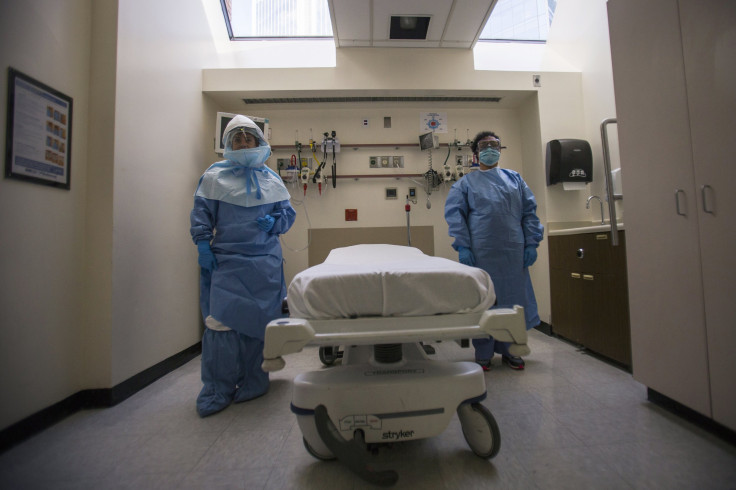Ebola In NYC 2014: Is Bellevue Hospital Ready For The Virus?

A single case of Ebola has surfaced in New York City, underscoring that despite extensive efforts to keep the virus out of the U.S., no plan is infallible. Health officials insist that Bellevue Hospital in Manhattan, designated the city’s go-to treatment center for Ebola, is capable of handling Ebola patients, however the apparent bungling of a case in Texas and strained emergency equipment supplies have raised concerns about the readiness of U.S. hospitals to confront Ebola.
"We had the advantage of learning from the Dallas experience," New York Gov. Andrew Cuomo said Thursday. "We are as ready as one could be for this circumstance.” Earlier this month, Cuomo designated eight hospitals across New York state as “Ebola ready.” The treatment centers are part of the governor’s Ebola preparedness plan and have been given special training on how to deal with someone who is admitted with Ebola-like symptoms, including asking about a patient’s recent travels.
Dr. Craig Spencer, who returned from Guinea 10 days ago, has been quarantined at Bellevue Hospital in Manhattan after he tested positive for Ebola on Thursday. Spencer contacted health officials immediately after he started showing symptoms of the virus, including a 100.3 fever and gastrointestinal symptoms. Authorities are scrambling to determine whether he may have posed a risk to others before he was admitted to Bellevue, although health experts say patients with Ebola are only contagious once symptoms occur. Spencer’s fiancée and two friends were quarantined but showed no symptoms, according to the Associated Press. His fifth-floor apartment in the Bronx, at West 147th Street, was sealed off.
Bellevue has a long history of treating patients with highly infectious diseases, including several years of taking in tuberculosis patients, according to Scientific American. “Bellevue is legendary for having taken on a host of challenges over the years,” New York City Mayor Bill de Blasio said at a press conference Thursday. The hospital, which has 828 beds, has set up four separate isolation rooms for potential Ebola cases and has said it can convert additional rooms into Ebola isolation rooms if necessary.
Medical staff has been trained in how to properly cover themselves with several layers of hazmat clothing to avoid contamination. Specialized suits that leave no skin exposed and include air-purifying respirators will be worn by medical personnel coming into contact with patients in the later stages of the disease. Smaller anterooms attached to the isolation rooms allow health care workers to put on and take off their protective gear upon entering and leaving the patient’s quarters, according to New York magazine. The hospital has said it can convert additional rooms into Ebola isolation rooms if necessary.
The hospital is also taking extra precaution with the discarded garments. All gear will be sanitized before being disposed of, New York reported.
A distributor of hazmat suits, Indiana-based DQE, has said it only sells protective gear to emergency responders after reported supply shortages. “The supply chains for the garments are starting to become strained,” DQE President Tony Baumgartner told The Hill last week.
In Dallas, where the country’s first Ebola patient diagnosed in the U.S. was treated and later died, hospital staff was underprepared for such a serious case. Nurses treating Thomas Duncan, a Liberian national who contracted the virus before coming to the U.S. and was admitted to Texas Health Presbyterian Hospital in September, had flimsy protective gear and no proper training in how to handle a patient with Ebola, according to the Los Angeles Times. Despite the hospital’s impressive credentials and diplomas from top-notch medical schools, its emergency department failed to meet certain nationally recognized benchmarks for handling ER patients. The hospital delayed identifying Duncan as having Ebola, an error that many have attributed as having led to Duncan’s death on Oct. 8. The patient’s family has considered filing a lawsuit against the hospital for potential malpractice.
U.S. President Barack Obama contacted de Blasio on Thursday to express the federal government’s support to help contain the spread of Ebola. New York health officials said the city “is taking all necessary precautions to ensure the health and safety of all New Yorkers.”
“The chances of the average New Yorker contracting Ebola are extremely slim,” a statement posted on the New York City Health and Hospitals Corporation's website said. “Ebola is spread by directly touching the bodily fluids of an infected person. You cannot be infected simply by being near someone who has Ebola."
© Copyright IBTimes 2024. All rights reserved.






















